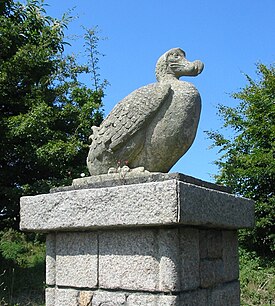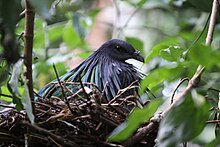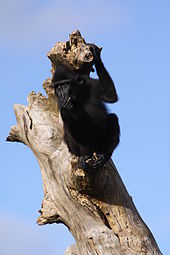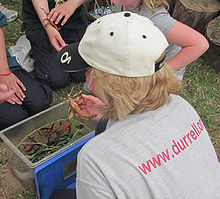Jersey Zoo
| Jersey Zoo | |
|---|---|
| particularities | Refuge for rare and endangered animal species |
| surface | 13 hectares |
| opening | March 26, 1958 |
| Animal species | 133 species |
| Individuals | 1400 animals |
| Visitor numbers | 180,000 (2014) |
| organization | |
| Sponsorship | Durrell Wildlife Conservation Trust |
| Member of | WAZA , EAZA |
|
The dodo is the symbol of the trust and the zoo. The statue of the dodo stands at the entrance to the zoo. |
|
| www.durrell.org/wildlife/visit | |
The Jersey Zoo (formerly Durrell Wildlife Park ) is a zoological garden that was founded by the English author and naturalist Gerald Durrell (1925-1995) in 1958 on the Channel Island of Jersey . It is operated by the Durrell Wildlife Conservation Trust , which has been based here since 1964 (formerly Jersey Wildlife Preservation Trust ) and has around 170,000 visitors a year, despite the small number of large animals and its relatively remote location. The number of visitors varies with the location of tourism in Jersey.
The Jersey Zoo or Durrell Wildlife Park has always focused on the conservation of rare and endangered animals. The species program includes mammals , birds , amphibians and reptiles , a total of over 130 species. Many of the species that live here are on the highest or second highest endangerment level (level 1 or 2) on the Red List of Threatened Species , so they are acutely threatened with extinction.
location
The park is located at Les Augrès Manor , Trinity , Jersey , about five miles north of Saint Helier , the capital of Jersey. It opened on March 26, 1958.
The park has an area of around 13 hectares and is located in a landscape park with water surfaces. The trust attaches great importance to the preservation of the island's natural flora and fauna , and large parts are designated as natural areas. The restrained planting of flowers and fruit trees on the property creates an attractive environment for a wide variety of birds and insects that are native to the island, but have generally become rarer, such as the house sparrow and song thrush .
There are more than 50 nesting boxes scattered around the site , which are used by a variety of birds, including barn owls , kestrels and swallows . Other common animals are squirrels , bank vole, and treecreeper .
history
Durell began his career as an animal catcher for zoos, but came to believe that it was more important that zoos care more about the preservation of animals rather than display them for entertainment. He told this story in his book Menagerie Manor .
The Durrell Wildlife Park gained international fame on August 31, 1986. A five-year-old boy fell into the gorilla enclosure and initially remained unconscious. The 25-year-old gorilla "Jambo" stood protectively between the child and its conspecifics. When the boy regained consciousness and began to scream, the gorillas withdrew. The child was rescued largely unharmed by two guards and a paramedic. The incident is recorded on video and was received worldwide in the press and on television news.
In January 2008, the plans called New Vision were unveiled. They are designed to secure the Jersey Trust for the next 50 years. These ambitious plans focus on what are known as TopSpots : places with the greatest diversity of species such as islands and highlands. The cost has been estimated at around £ 46 million over the next five years. This sum has to be raised by the public purse and donors. There are nine main development points, which are prioritized differently for reasons of cost.
- African Bai - The idea is to create an environment that reflects the conditions of the African habitat to which the West African lowland gorillas will be adapted when it is one day safe enough for them to live there again. The multimillion pound project would include some sort of gym and a renewed environment. The family size could be increased or an additional group would live next to the existing one. Other animal species from the region would also be settled in the enclosure, such as brush ear hogs , capotters and monkeys .
- Mascarenia - The idea is to keep the mammals, birds and turtles of Madagascar in one place. You may also want to bring in species from Mauritius , Comoros, and Seychelles . Around this walk-in enclosure, in which bats could also live, enclosures could be built that would house the lemurs , finger animals , narrow-striped mongooses and the Madagascan giant rat .
- A new visitor center designed to enhance the overall experience of the zoo for visitors. A Hall of Fame should also be part of it.
- Eco-lodge cabins , which should allow visitors to spend their vacation at Durell, taking into account all ecological aspects.
- New Reptile and Amphibian Center , which would enable Durell to expand and improve the care of species susceptible to the changing conditions of the environment.
- Redesign of Les Augres manor , transforming it into a kind of hotel, so that visitors can spend their holidays there.
- Improvements in training facilities
- Development of the Royal Pavilion into a full-fledged conference center
In May 2011, a new Princess Anne Visitor Center was officially opened. It is now possible to visit the restaurant independently of a visit to the zoo. A webcam system was installed in the park. Cameras were installed in the meerkat enclosure, as well as in the enclosures of the Telfair skink , the fruit bats and in the Kirindy Forest, home to rare and very colored birds. Thanks to the webcams, interested parties can observe the animals during their main activities. In 2015, the silverback gorilla Indigo, who lives in the park, was chosen to be the mascot of the 2015 Island Games .
Animal houses

EX Extinct (after the year 1500 extinct )
EW Extinct in the Wild (in nature extinct)
RE Regionally Extinct (regional extinct)
CR Critically Endangered (an endangered species)
EN Endangered (high risk)
VU Vulnerable (endangered)
NT Near Threatened (potentially endangered)
LC Least Concern (not endangered)
DD Data Deficient (insufficient data basis)
NE Not Evaluated (not assessed)
Jewels of the Forest
The house, which opened in 2004, houses the following birds, among others
-
Bartlett dagger-stinging dove

-
Pubic thrush

-
Elven blue bird

-
Blue-capped jay

-
Sumbawa thrush

-
Green-winged pigeon

-
Cap pitta

-
Collar dove

-
Omeijähling

-
Palawan peacock pheasant

-
Rice finch

-
Sun bird

-
Red-tailed jay

Cloud forest
Opened in 1999, the Nebelwald exhibition center was the first closed building near Durrell to show a mixed population, including carnivorous species
-
Spectacled bear

-
Yellow belly organist

-
Dominican Cardinal

-
Purple tangerine

-
Black howler monkey

-
South American coati

-
Silver-throated tangare

Princess Royal Pavilion
The pavilion was opened by Princess Anne in the 1970s and serves as a conference and training center. Films showing the work of the Trust are shown in the movie theater, and there are also art exhibitions. The global activities of the Trust are also presented in the pavilion. A number of species that are kept for educational purposes live in the pavilion, for example
-
Corn snake

- Rainbow boa
- Triangular snake
- Bluetongue Skink
- Archispirostreptus gigas
-
Madagascar hissing cockroach

- Australian ghost insect .
The Gaherty Reptile and Amphibian Center
The reptile house is home to a wide variety of reptiles and amphibians. It is named after the Canadian philanthropist Geoff Gaherty.
Reptiles
- Anolis roquet
-
Wide-brimmed tortoise

-
Hind Indian hinged turtle

-
Flat-backed tortoise

-
Galápagos giant tortoise

- Raptic lance viper
-
Spiny Edge Turtle

-
Caribbean green iguana

- Jersey sand lizard
-
Jamaican boa

-
Komodo dragon

-
Adder

-
Nactus coindemirensis

-
Panther chameleon

-
Sceloporus serrifer

- Laemanctus serratus
-
Scorpion-crusty lizard

-
Radiated tortoise

-
Telfair skink

-
Tiger python

-
Hispaniola eared turtle

-
Utila iguana

Amphibians
-
Tree Hollow Toad Tree Frog

-
Tree toad

- Blue tree climber
-
Eleutherodactylus johnstonei

-
Strawberry frog

-
Excidobates mysteriosus

-
Striped leaf climber

-
Ingerophrynus galeatus

- Jersey Agile Frog
-
Leptodactylus fallax

-
Mallorca Midwifery Toad

-
Terrible poison dart frog

Invasive Species
One of the issues addressed by Durell is the consequences of non-native species being released into the environment; the damage that can occur with case studies from the park.
Discover the desert
The Discovery Desert exhibition opened in April 2008 and was designed to provide the meerkat family with![]() more living space to keep them from digging for freedom. This enclosure serves as a mixed enclosure in which species with comparable demands on the environment live without threatening each other, for example the fox mongoose
more living space to keep them from digging for freedom. This enclosure serves as a mixed enclosure in which species with comparable demands on the environment live without threatening each other, for example the fox mongoose![]() .
.
Gorillas
The western lowland gorillas![]() have lived in the park since it opened in 1958. The female cub named N'Pongo, who was initially kept alone, was later joined by another younger female named Nandi . Gorillas are the icons of the park to this day.
have lived in the park since it opened in 1958. The female cub named N'Pongo, who was initially kept alone, was later joined by another younger female named Nandi . Gorillas are the icons of the park to this day.
The current facility consists of a spacious outdoor area and three indoor rooms, two of which can be viewed by visitors. The third, smallest room cannot be seen from the outside. One future project is the construction of a larger gorilla complex with high-quality furnishings in which more animals can be accommodated. Other species are also to be settled that occur together with gorillas in their natural environment, for example the brush-eared pig.
Brush-eared pigs
Brush earpigs![]() were introduced to the park in August 2009 after two sows were relocated from Whipsnade Zoo . They live in a new enclosure with a viewing platform for visitors that was built by volunteers. Information boards at this enclosure would like to draw attention to the problem of poaching for meat production. This problem, which also affects the gorillas, is known as bush meat . In 2011 a breeding program was started with the arrival of a boar.
were introduced to the park in August 2009 after two sows were relocated from Whipsnade Zoo . They live in a new enclosure with a viewing platform for visitors that was built by volunteers. Information boards at this enclosure would like to draw attention to the problem of poaching for meat production. This problem, which also affects the gorillas, is known as bush meat . In 2011 a breeding program was started with the arrival of a boar.
Tamarins and marmosets
The tamarins live in two areas of the park, some like the golden lion tamarins and the mustache tamarins live well protected in a separate enclosure, while others like the red-cheeked lion tamarin and the silver monkey live freely in a small forest in order to strengthen them with a more natural way of life.
-
Golden lion tamarin

-
Golden-headed lion tamarin

-
Imperial mustache tamarin

-
Red-cheeked lion tamarin

-
Silver monkey

-
Jumping tamarin

-
Two-tone tamarin

Central Valley
The Central Valley, running through the center of the park, forms a natural barrier and water source for the local species that live here. It was renatured by a project that cost £ 1 million by 2002 and is now an oasis for species such as kingfishers , bank vole , butterflies, dragonflies and a few other species of waterfowl. In the course of the renaturation, two rare endemic orchid species were reintroduced in 2005 , namely Jersey Orchid ( Anacamptis laxiflora ) and the overlooked orchid (Dactylorhiza praetermissa).
-
Chough

-
Chilean flamingo

-
Paradise crane

-
Greater Flamingo

-
Red-necked goose

-
Swan goose

-
South Africa crowned crane

-
White-naped crane

-
Dwarf otters

- The Chough was exterminated on Jersey in the 19th century, but has returned. Durell has started a breeding program, set up a group on the park grounds, and hoped that such a free colony would be established.
Aviaries
There are several aviaries spread over the area, which house a number of birds from all over the world. These bird houses are each specially built and equipped and represent a habitat in which the birds would also live in their home when they were released into the wild. They are big enough for the animals to fly short distances and find their food on the ground.
-
Balistar

-
Blue masked amazon

-
Edward's Pheasant

-
Congo peacock

-
Madagascar flight bird

- Mauritian Parakeet
-
Montserrattrupial

-
Rose pigeon

-
Red-crested turaco

-
Hornbill

- Scaly head chalk
-
Sunda white-throated duck

- Tropical mockingbird
-
Vietnam pheasant

-
Bald ibis

Orangutans and gibbons
In an enclosure from the 1990s, the orangutans have a large outdoor area with activity options. The enclosure consists of a large main house and two extensive islands that are surrounded by a moat. The orangutan family has lived in the park since 1968 and is from Sumatra . Originally Durell wanted Borneo orangs, but it was decided that they wanted to focus on the rarest species.
There are currently seven animals living in the park. The lead male (Dagu), three adult females and three children of these females. The orangs share their enclosure with two gibbons .
Macaques
There have been macaques in the park since 1964 , living in an enclosure on the edge of the valley. They have reproduced well.
Maned wolf
The maned wolf had lived in Durell since 2001 and replaced the Przewalski horse . However, there are currently no wolves in Durrell.
Teal aviaries
A play on words because 'teal' denotes both the color petrol and certain types of duck. These bird houses are painted in petrol.
-
Bernierente (English Madagascar teal)

-
Hottentottenente (Engl. Hottentot teal)

-
Madagascar pension

-
Marble duck

-
Bog duck

Lemurs
Durrell is home to six species of lemurs . Five of them live spread out on the site, one, the red-fronted lemurs, live exclusively in the Kirindy Forest. Some of the animals form the voice background of the Madagascar exhibition Kirindy Forest Lemurs, especially the ring- tailed lemurs, have a complex and pronounced acoustic communication.
-
Alaotra bamboo lemur

-
Finger animal

-
Ring-tailed lemur

-
Red Vari

-
Red-fronted lemur

-
Black and white vari

Flying fox tunnel
A large tunnel with a plastic roof, partly made of used car tires, was completed in 2011. It is the new home of two species of flying fox . The tunnel is close to the organic farm and the apple orchard.
Kirindy Forest
A major project was the remodeling of a walled garden in the Kirindy Forest. With an environment comparable to that of the dry forests of Madagascar, a home was created for the finger animals, Votsotsas and mongooses. The enclosure was laid out in such a way that the species that live together in Madagascar can live together here. The facility is also a large walk-in aviary.
-
African pygmy duck

-
Amber duck

-
Finger animal

-
Hammer head

-
Ring-tailed lemur

-
Madagascar turtledove

-
Madagascar weavers

-
Red-fronted lemur

-
Narrow striped mongoose

-
Crested ibis (Lophotibis)

-
Stilt

-
Votsotsa

-
White-backed Whistling Goose

-
Widow Whistling Goose

Successes in the release and conservation of species
To show that the conservation work is working, some animals have been reintroduced to their original homes as part of reintroduction programs.
Mauritius falcon
In 1976 there were only four wild Mauritius falcons left , two of which were breeding pairs. Nevertheless, a resettlement on Mauritius succeeded with up to 1000 individuals in the meantime.
Przewalski horse
Durell was part of a collaboration between several zoos that successfully reintroduced the Przewalski horse ![]() to their natural environment after the natural population became completely extinct.
to their natural environment after the natural population became completely extinct.
Work in jersey
Helping the local species ("Help for local species")
Local Endangered Amphibians
Durell also works closely with local conservation groups to help support declining populations of Jersey sand lizards , Jersey common toads and Jersey agile frogs .
Local Rare and Endangered Plant Species
In addition to conservation work for endangered animals, Durrell is also committed to helping Jersey's endangered flora.
Four species are currently being cultivated: the forest strawberry , Dianthus gallicus (Jersey carnation), thin-leaved nude fern (Jersey fern ) and real toadflax . Other plants should be supported as soon as seeds or cuttings are available. Some of these plants have become so rare that finding them is a major challenge.
Bird Reintroduction In 2010, Durell made efforts to reintroduce species of birds that used to populate the Jersey cliffs but were long extinct. The Chough was at the center of the first effort and can be seen again in the park's Central Valley. There are plans to join other birds such as B. to proceed similarly to the gold hammer.
Durrell overseas
- Even if it is no longer present at Durrel, the reintegration in Assam in India is accompanied and monitored. This species still needs support. Some specimens were released into the wild in 2008 and there appears to be good progress in conservation.
- There are reports from the Cayman Islands that there has been success in reintroducing the blue iguanas. The species has been saved from extinction. That was despite a major setback when hooligans invaded a breeding station and slaughtered numerous specimens, including young and pregnant females.
- This species was considered extinct and was found again when another was searched. Durrell has teamed up with Malagasy authorities to investigate this species further. After no further specimens could be found, some animals were brought to Jersey in order to develop a breeding program with the experience of other Malagasy duck species in order to make the species native to Madagascar again.
- In 1995 this snake was called the rarest in the world. At present they have been successfully resettled on some islands, where they can live safe from predators and environmental toxins.
There were other successful projects of the following types:
- Mountain coati
-
Dominican weevil

- Floreana Mockingbird
-
Guenther's day gecko

- Haiti giant gall wasp creep
-
Cuban weevil

-
Malagasy beaked turtle

-
Mangrove Darwin's Finch

-
Mauritius spectacle bird

-
Mauritius weaver

-
Round Island Boa

-
Telfair skink

-
White-footed tamarin

- Actual zaguti
Completed programs
- African elephants
- Aromobatinae
- Bornean orangutan
- Brow-browed caiman
- Lowland tapir
- cheetah
- Common porcupine
- Gold tree climber
- Buck boar
- Humboldt penguin
- Leopards
- lion
- Lisztaffe 1972–2009
- Macaws
- Umbilical pigs
- Rhinoceros iguana 1974-2010
- Parmawallaby 1959-2008
- Partula snails
- Porcupines
- Chimpanzees
- Snow owl
- Snow leopard
- Serval
- Standing's day gecko
- Frontal lobe basilisk
- Volcanic rabbit
- White ear pheasant
- Bald monkey
Durrell Wildlife Camp
In 2012, construction began on Durrell's Wildlife Camp . The park can thus offer visitors overnight stays and services.
In a small wood to the west of Les Augrès Manor , square 9 × 9 m wooden platforms were built that support a total of twelve tents designed as geodesic domes. These tents each contain a sanitary room with shower and toilet and power connection. Two other platforms offer communal facilities and a room for spa treatments. All rooms have Wi-Fi access.
Individual evidence
- ↑ Information retrieved from jersey.com on December 6, 2015
- ↑ Park press release 2010 , accessed on December 6, 2015.
- ↑ Park press release 2010 , accessed on December 6, 2015.
- ↑ Information retrieved from jersey.com on December 6, 2015
- ↑ Visitor numbers falling at Durrell - could it be forced to close? , Jersey Evening Post, February 13, 2015, accessed September 3, 2015
- ↑ Time to be a zoo again , notice on the official renaming on April 3, 2017, accessed on September 3, 2017.
- ↑ Presentation of the animal species at Durrell ( Memento of the original from December 21, 2015 in the Internet Archive ) Info: The archive link was inserted automatically and has not yet been checked. Please check the original and archive link according to the instructions and then remove this notice. Retrieved December 9, 2015
- ^ Durrell Wildlife Conservation Trust: Press Information . Retrieved May 26, 2012.
- ↑ The Princess Royal visits Jersey
- ↑ Indigo's page on the Island Games 2015 website ( memento of the original from January 19, 2015 in the Internet Archive ) Info: The archive link has been inserted automatically and has not yet been checked. Please check the original and archive link according to the instructions and then remove this notice.
- ^ IUCN classification standards
- ↑ http://www.birdlife.org/datazone/species/factsheet/22696373 Birdlife international
- ^ Durrell Wildlife Camp
Web links
- official website
- Durrell Wildlife Conservation Trust . In: jersey.com . Jersey.com. Retrieved May 26, 2012.
Coordinates: 49 ° 13 ′ 41 ″ N , 2 ° 4 ′ 30 ″ W.

















